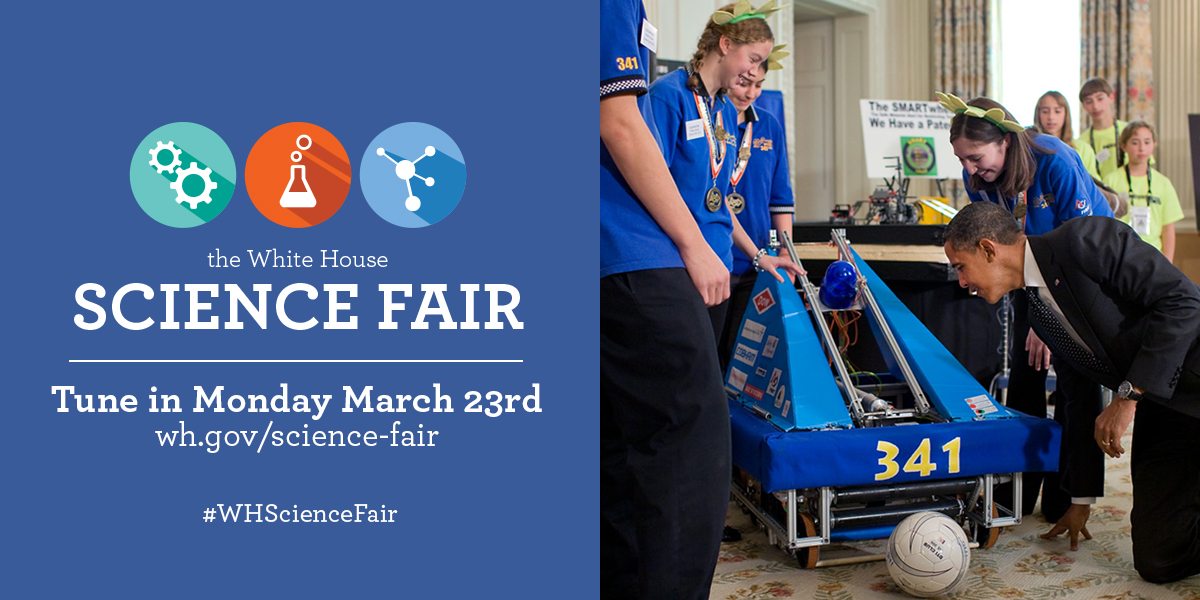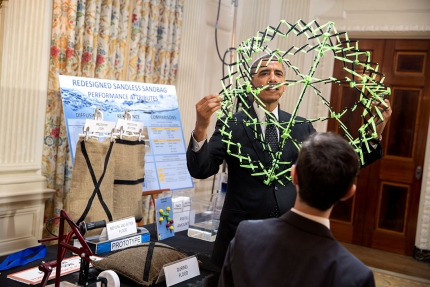Office of Science and Technology Policy Blog
Continuing Engagement to Ensure the Nation’s Biosafety
Posted by on March 16, 2015 at 9:09 AM EDTLife-sciences researchers and public health workers play key roles in mitigating the threat of infectious diseases in the United States and around the world. Working with pathogens in the laboratory is vital to ensuring that the United States and the global community have the right cutting-edge tools—such as drugs, diagnostics, and vaccines—to counter the ever evolving threat of infectious disease and ensure biomedical progress. It is also the responsibility of the Government to ensure that this research is conducted safely and securely.
That’s why the Federal Select Agent Regulations were enacted in 2002 to oversee the possession, transfer, and use of bacteria, viruses, fungi, or toxins that have the potential to threaten public and agricultural health. In order to better adapt policies to the current landscape, the National Security Council and Office of Science and Technology Policy (OSTP) sent a joint memo in August 2014 to federal departments and agencies involved in life-sciences research, urging them to take immediate and longer-term steps to address the underlying causes of recent laboratory incidents and strengthen overall biosafety and biosecurity in the United States.
Among a number of robust steps, the memo directed the formation of an interagency group to comprehensively review the impact that the current select agent regulations have on science, technology, and national security. To ensure that this review benefits from diverse perspectives and the broadest possible input, OSTP is holding a series of stakeholder listening sessions, the first of which was held on February 17, 2015, to ensure that members of the scientific, regulatory, and security communities, as well as interested citizens, have an opportunity to provide direct feedback on this important issue.
In addition, today OSTP issued a Request for Information to solicit feedback from the broader public and expert community.
Anyone can submit comments through this request for information and we welcome your input. The Request for Information, along with instructions on how to submit input, can be found in the Federal Register here. The comment period will close at 5pm ET on March 30, 2015.
May Chu is Assistant Director for Public Health at OSTP, Dylan George is Senior Policy Advisor for Biological Threat Defense at OSTP, and Kushal Seetharam is a Student Volunteer at OSTP.
Learn more aboutMusings on Pi(e)
Posted by on March 14, 2015 at 9:26 AM EDTI was fortunate enough to grow up next to a set of fruit orchards in California and had access to all kinds of great fruit including cherries, plums, peaches, blueberries, nectarines, and apples. Thanks to my very wise grandmother, we were able to learn that pie was an excellent breakfast. A big glass of milk with an extra-large slice of pie would get me set for my active day. Luckily I never lost touch with my roots and pie only grew on me. So much so that it became a one of my staples through my college years and graduate work (pumpkin pie, in particular, powered me through both my Ph.D. qualifying exam and thesis defense). And that brings me to why I love today. I get to combine my two great loves -- pie and pi.
I could go on about all the different types of pie I love (for the record, it’s chocolate mousse or pecan on Friday nights), but today is extra special. Today only happens once every 100 years. It’s March 14, 2015 which is 3.14.15 and if you’re reading this at 9:26 and 53 seconds you’ll get 3.141592653 – the first 10 digits of pi (ok, somewhere between 9:26:53 and 9:26:54 because it’s an irrational number - more on that in a bit). In fact, to see the first 100,000 digits of pi check this out.
But why is pi, a number we represent with the symbol π, so important? Well, it’s literally one of the foundations of our society. In fact, every civilization had to figure out pi. The Greeks, Ancient China, India, Egypt, the Babylonians, all worked hard to calculate it as precisely as they could. How old is it? Archimedes figured out a way to calculate pi over 2000 years ago and the ancient Egyptians and Babylonians may have used pi long before that. Think about that for a second -- all of these societies figured it out independently. That’s how prevalent – and obvious -- pi is!
Now if you’re reading this while eating pie (as you should be), where is pi used today? Just look for a circle. Take for example a car’s speedometer. How does it work? You need to know the distance around the car’s wheel. What’s the answer there? 2 x pi x the radius of the wheel (or 2πr) and once you know how many times it spins in a time interval, you’ve got your answer! Need to know how much cloth you’re going to need to cover your round picnic table? It’s the area of the table: pi x radius-squared (or πr2) How much air is there in a basketball? Calculate the volume using (4/3) x pi x radius-cubed (or (4/3)πr3).
Learn more about TechnologyPi Day 2015: A Day So Fun, it’s Irrational!
Posted by on March 13, 2015 at 5:41 PM EDTThe importance of math education and numeracy skills to all Americans cannot be overstated and so, in support of President Obama’s continued focus on celebrating STEM enthusiasts of all ages, we at the White House couldn’t resist getting in on the Pi Day fun!
From left: U.S. Chief Technology Officer Megan Smith, U.S. Chief Data Scientist DJ Patil, Associate Director for Science Jo Handelsman, and Associate Director for National Security and International Affairs Patricia Falcone celebrate an early Pi Day by chowing down on pie on March 13, 2015. (Photo by Matthew McAllister)
March 14 is Pi Day (3-14 or 3.14), but 2015 is a special year for pi, one that occurs every 100 years. This year Pi Day is defined to five digits by the date (3-14-15 or 3.1415).
And, if you’re reading this on March 14, 2015 at 9:26 and 53 seconds, the exact date and time matches the first 10 digits of pi - 3.141592653!
Mathematically, the constant pi is defined as the distance around a circle (the circumference) divided by the distance across it (the diameter). The digits in pi never end and never form a repeating pattern; in mathematical terms it’s known as an irrational number, meaning it cannot be represented as a fraction.
Many ancient civilizations recognized the unique relationship between pi and circles. For example, the Babylonians approximated the value of pi as 3, based on the relationship between the area and radius of a circle. Later, the Greek mathematician Archimedes formulated a geometrical algorithm to estimate pi by comparing the perimeters of polygons and circles. Today, pi can be calculated to more than a trillion digits thanks to improved computational technology.
Here are a few examples of how pi appears outside of the classroom and in our daily lives:
Pi is used for calculating the volume of cylinders, spheres, and other circle-based shapes. Whether it’s for sports equipment, such as calculating the volume of the basketballs for the upcoming March Madness tournament, or figuring out how many apple slices fit into a standard, 9-inch pie dish, pi is an integral part of the measurement.
Calculations of curves rely on pi, including curves that describe oscillations or periodic motion. We experience oscillatory patterns everyday through sound, swings on a playground, and the springs in car suspensions.
Pi is also beautifully represented in natural phenomena. When an object is thrown into a pool of water, the ripples propagate in near-perfect concentric circles. We also find arcs and rings in a rainbow after a spring storm, the trunks of trees, and even the rings of Saturn.
Each year, Pi Day is to makers, innovators, and inventors around the country what the Super Bowl is to football fans - a chance to celebrate and share the unique, fun, and useful applications of this number in what they create. Community, library, museum and school maker spaces across the country, from Buffalo, NY to Normal, IL are hosting Pi parties and workshops to work on projects and activities that integrate pi.
Learn more about TechnologyAnnouncing the Fifth White House Science Fair!
Posted by on March 12, 2015 at 5:45 PM EDT
The Obama administration is committed to helping inspire young people across the nation to get excited about science, technology, engineering, and mathematics (STEM), and to celebrating the extraordinary K-12 students that already are accomplishing great work in these fields. The President has often said that it is just as important to celebrate the winners of science fairs as it is to celebrate the winners of sporting events.
That’s why the President is hosting the fifth White House Science Fair on March 23, welcoming more than 100 of the nation’s brightest young minds with some showcasing innovative inventions, discoveries, and science projects. The President will meet with and congratulate these students, who, as budding engineers, scientists, and researchers are on deck to help solve some of the greatest challenges of our time.
Previous White House Science Fairs have featured young innovators who have built electric cars, search-and-rescue robots, and marshmallow cannons; helped develop promising flu vaccines; and studied human genome data to find potential treatments for cancer; among many other projects.
Video Contest for High School Students Looks to a Robot-Assisted Future
Posted by on March 11, 2015 at 10:12 AM EDTThe movies have taught us a lot about what robots can do: drive careening fire engines through the streets of Los Angeles, escape unscathed from burning oil tanker trucks, serve as backup medical officers on starships, the usual. Right?
Well, not yet at least.
The truth is, while robots are evolving quickly, and are already used in domains as diverse as manufacturing and healthcare, they are still mostly relegated to performing tasks that are routine and repetitive, and to performing those tasks in environments like factories or warehouses where obstacles and other surprises are rare.
Happily, things are beginning to change. A mix of public and private investment – supported in part by the National Robotics Initiative launched by President Obama in 2011 – is speeding the development of machine learning algorithms and increasingly advanced hardware. That in turn is facilitating the development of robots able to operate creatively in human-designed spaces, opening a growing spectrum of possible applications.
In what promises to be one of the more dramatic demonstrations of that potential, the Defense Advanced Research Projects Agency will in June host the DARPA Robotics Challenge Finals in Pomona, CA. At this event, 25 teams will compete for $3 million in prizes as they show off their robots’ abilities to provide humanitarian assistance after a natural or manmade disaster such as an earthquake or nuclear power plant accident. The robots, which will vary in design, will have to demonstrate that they can perform tasks like driving a vehicle to a disaster zone and disembarking without assistance, navigating around and over rubble, climbing stairs, cutting holes in walls, and turning valves on and off.
If robots have a future helping in disasters, what else might they do with and for people in the years and decades ahead? In conjunction with its Robotics Challenge, DARPA recently launched Robots4Us—a contest that asks high school students to produce 2- to 3-minute videos envisioning the kind of robot-assisted future they’d like to see. Five winners will get free trips to California in June to attend the two-day Robotics Challenge Finals and participate in a panel with roboticists and futurists to discuss the kind of future they would – and would not – like to see with robots.
If you are a U.S. high school student, check out the Robots4Us website, fire up a video cam, and get your entry in by April 1. Yours will be the first generation to live and work closely with robots. Have a say in what kind of a world you want that to be!
Richard Voyles is Assistant Director for Robotics and Cyber-Physical Systems at the White House Office of Science and Technology Policy.
Learn more about TechnologyOpen Education Week 2015
Posted by on March 11, 2015 at 9:17 AM EDTAs we celebrate Open Education Week 2015, we look forward to implementing the new U.S. Open Government Partnership National Action Plan to promote Open Educational Resources and building momentum for Federal open education initiatives. The availability of high-quality, low-cost digital content in our schools is a priority for the President and a pillar of his ConnectED Initiative. Fostering the use of Open Educational Resources in our nation’s K-12 and post-secondary classrooms can help meet this goal.
Open Educational Resources are learning tools that reside in the public domain or that have been released with intellectual property licenses allowing their free use, continuous improvement, and modification by others. Open Educational Resources can deliver two great benefits for students: lower cost in obtaining the educational resources needed to succeed in school, so that students and schools can redirect funds for other instructional needs; and access to a universe of high-quality, updated content that can be tailored minute-by-minute by educators to reflect new developments and current events.
Learn more about Education,
- &lsaquo previous
- …
- 11
- 12
- 13
- 14
- 15
- 16
- 17
- 18
- 19
- …
- next &rsaquo
White House Blogs
- The White House Blog
- Middle Class Task Force
- Council of Economic Advisers
- Council on Environmental Quality
- Council on Women and Girls
- Office of Intergovernmental Affairs
- Office of Management and Budget
- Office of Public Engagement
- Office of Science & Tech Policy
- Office of Urban Affairs
- Open Government
- Faith and Neighborhood Partnerships
- Social Innovation and Civic Participation
- US Trade Representative
- Office National Drug Control Policy
categories
- AIDS Policy
- Alaska
- Blueprint for an America Built to Last
- Budget
- Civil Rights
- Defense
- Disabilities
- Economy
- Education
- Energy and Environment
- Equal Pay
- Ethics
- Faith Based
- Fiscal Responsibility
- Foreign Policy
- Grab Bag
- Health Care
- Homeland Security
- Immigration
- Innovation Fellows
- Inside the White House
- Middle Class Security
- Open Government
- Poverty
- Rural
- Seniors and Social Security
- Service
- Social Innovation
- State of the Union
- Taxes
- Technology
- Urban Policy
- Veterans
- Violence Prevention
- White House Internships
- Women
- Working Families
- Additional Issues



